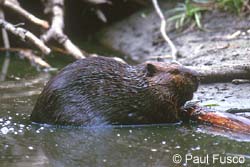Problems with Beavers
Beavers in Connecticut Booklet
Beaver/human conflicts have been increasing in recent years due to human encroachment on wildlife habitat and a growing and expanding beaver population. Because beavers have the ability to build dams to impound water, they can dramatically alter the environment in which they live. The problems beavers can cause fall into two main categories, tree cutting and flooding. In some cases, beaver activity can threaten property, agricultural crops, or public health and safety.
Beaver dams also may negatively affect other natural resources. For example, dams can serve as barriers to migrating fish and cause inundation and siltation of rare plant and animal habitats.
There are also instances when landowners are unwilling to tolerate any beaver activity on or near their property. Unfortunately, there are no known repellents that are effective against beavers and harassment generally does not cause beavers to abandon a site. In rare instances, such as when a young beaver has not established a territory, continual removal of dam material may persuade it to abandon the site.
If you are experiencing problems requiring removal of beaver on your property during the regulated trapping season (December 1 - March 31), you are encouraged to contact a volunteer beaver trapper or hire a licensed NWCO, who has been approved by DEEP to provide assistance with beaver nuisance problems. No additional permits are required from DEEP.
Outside of the regulated trapping season (April 1 - November 30), any landowner or municipality who is experiencing beaver problems should contact the DEEP Wildlife Division at 860-424-3011 regarding a special permit to trap beaver. The Wildlife Division may issue authorizations to trap beaver if damage threatens public health and safety (e.g., road flooding, well inundation, and septic leach field flooding), agricultural crops or livestock are damaged, or the property damage qualifies as severe. Landowners who feel that they qualify for a special out-of-season permit should call the Wildlife Division regarding an application and a list of volunteers and licensed companies that can conduct trapping activities.
DEEP also maintains a listing of persons who install water level control devices as a non-lethal method of mitigating damage caused by beaver.
In an effort to provide landowners with more detailed information regarding beaver conflicts, the Wildlife Division has developed two publications that describe a number of options that may help alleviate problems caused by beavers. For additional guidance, contact the Beaver Management Program at 860-424-3011.
Do you need additional help and advice concerning nuisance wildlife? Check out www.wildlifehelp.org and select "Connecticut" as your state to get started. WildlifeHelp.org is supported by the Northeast Association of Fish and Wildlife Agencies and the Northeast Wildlife Damage Management Cooperative.
Content last updated on October 20, 2016.


